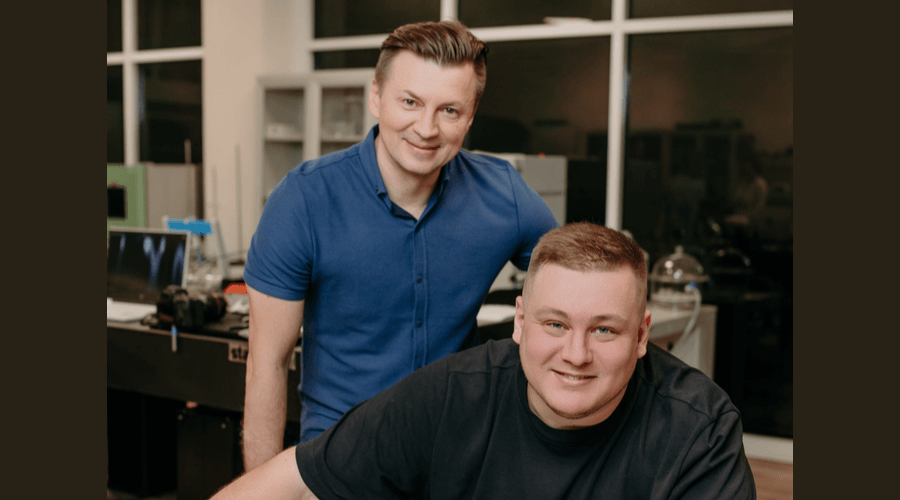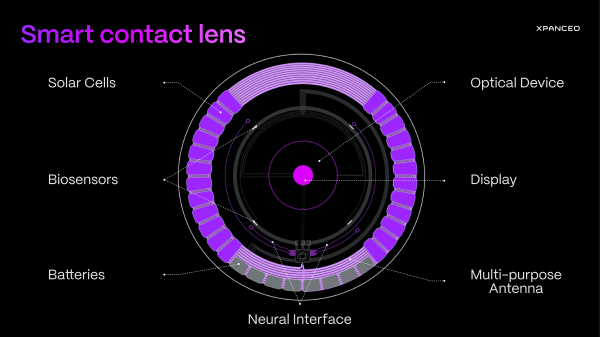Will the world's smartest contact lenses emerge in Dubai?

In a lab in Dubai, a Russian entrepreneur and a Ukrainian material scientist are working together on a project that may very well revolutionise how the world will interact with technology. Their mission: develop smart contact lenses that fuse biotechnology and electronics to unlock a realm of possibilities seen only in science fiction.
Roman Axelrod and Valentyn Volkov founded their startup, XPANCEO, back in 2021 in Moscow to develop these smart contact lenses. But the outbreak of the war in Ukraine a year later saw both men pack up with their team and head straight to Dubai where they are continuing their research and development (R&D).
The initial idea for smart contact lenses came from Axelrod, who, after successfully exiting his AI and robotics startup in Russia, wondered what the computer of the future would look like.
“Today, the smartphone is the most popular computer of humanity, but they are insufficient in terms of the goals humanity has set for the next 100 years,” says Axelrod who adds that smartphones are “old, outdated and simply bad. The best device is one that is invisible, weightless, and absolutely private. One infinite screen that connects all devices. So I started looking for people to help with this mission.”
His search led him to Volkov, a world expert in nanophotonics and advanced materials, with over 20-years of experience in the field.
“I initially had the impression that Roman was quite eccentric. However, after engaging in conversation with him, I found it challenging to disengage. It soon became apparent that my initial perception was inaccurate, and I developed a genuine curiosity about his interesting ideas,” he says.
At the time, Volkov was director of the Centre for Photonics and 2D materials at the Moscow Institute of Physics and Technology exploring the optical properties of van der waals and 2D atomically thin materials. Joining Axelrod was a risk, but one that would allow him to discover and invent a new type of computer and bring Axelrod’s vision to life.
A new computer
Technology typically has 10-year cycles before a revolutionary new device or gadget comes out to disrupt consumer habits. These cycles reflect a continuous search for efficiency, adaptability, and a more natural way to interact with technology. From desktop computers to smartphones and smart watches, devices are getting smaller and more powerful. It would be easy to dismiss smart contact lenses as fantasy but it was not too long ago when many dismissed the need for mobile phones, believing that the landline was sufficient. When Apple launched the iPhone in 2007, critics believed its lack of physical buttons would spell its demise. Since then, consumers have become dependent on their phones and now smart watches have become common, interacting with mobile phones to provide real time data on the user’s health and wellbeing.
“The next big thing that will come out is an XR/spatial computing device operated by sight, voice, gestures, and mind,” says Axelrod. “We have two possible options, either anything as a screen or eyes as a screen. From my point of view, it will evolve simultaneously. In five to 15 years from now, we will be able to use any surface as a screen and also deliver content directly to the retina.”
XR, or extended reality, is an umbrella term that encompasses various immersive technologies, including virtual reality (VR), augmented reality (AR), and mixed reality (MR). Virtual reality replaces the real world with a simulated environment, augmented reality overlays digital information onto the real world, and mixed reality merges digital objects with the physical environment in a way that they interact and coexist.
Currently, such experiences are provided through headsets and goggles like Meta’s Oculus range and Apple’s Vision Pro, but these headsets present a physical barrier with the real world and too much of an immersive experience to make them a viable “computer” for daily life.
For Axelrod, such gadgets are a “dead end. The form factor is very important. One shouldn’t look like an idiot with a limited range of view”.
Google’s Glass was intended to offer an AR experience without a bulky headset, but “it was built by techies for techies,” says Axelrod. “The hardware itself for 2011 was decent, but you looked like an idiot, an alien and there was nothing to do with those glasses. It was great hardware, but I couldn’t do anything with it.” For a wearable to succeed, “the product has to offer a use case that is so convenient that the average Joe will consider using this new product instead of cellphones.”
The use cases for smart contact lenses are many, from XR in gaming and education to healthcare and sports, scenarios where real-time feedback and data is important. The concept is not novel. In 2014, Google revealed it was working on smart lenses to measure blood sugar, before cancelling the project four years later, while both Samsung and Sony have filed patents for smart lenses. In the US, InWith Corporation and Innovega are startups developing smart contact lenses. Mojo Vision, which has raised more than $226 million, recently put its plans on hold to develop lenses and instead pivoted to micro-LED technology. Sensimed is currently the only company with the approval to sell its smart contact lenses, which measure eye pressure to determine glaucoma.
XPANCEO’s approach differs from its competitors in that it is working to create a new material for its lenses, one thin enough to fit comfortably on the eye, with enough computing power to enable different use cases like enhancing the user’s vision in lowlight, as well as a battery life to last the whole day.

“The perfect contact lens should be like the normal one we have right now,” says Volkov. “We are building the gadget of tomorrow with the work tools of today. You improve your skills during the process and we are trying to use the best of our skills. Sometimes it works, sometimes we have a problem. The idea is great which makes it a good motivation.”
The first iteration of XPANCEO’s contact lenses will allow for lowlight and enhanced vision. The second will focus on health with the ability to track markers like stress, blood sugar, body temperature and dry eyes. The third iteration will offer full functionality, with the ability to show visual content on the lenses. But there are both technological and biological hurdles to overcome. XPANCEO is essentially trying to shrink a smartphone down into a contact lens that is compatible with the biological environment of the human eye.
Even if Volkov and his team manage to develop a new material to enable this, it may be years before regulatory approvals can allow such a device onto the market, especially if it is classed as a medical device. Concerns over privacy will also need to be addressed since the lenses will have the ability to record video and take pictures, but this issue can be overcome if the lenses turn a different colour when that happens, alerting others that the user is recording.
The company has a few financial backers and will soon start raising investment to fund its research and development and launch its prototype.
“We have a very strong research team. The aim is to not only create this new level gadget, but to produce a quite a lot of knowledge,” says Volkov. “We are going to use new materials. The Stone Age finished not because they ran out of stones, but because new materials were discovered. It is important to put on the table the prototype, because if you have nothing then you have nothing to improve.”
The company is partnering with two universities in the UAE to gain access to their labs and provide an opportunity for their students to work with XPANCEO. Such collaborations are essential if a deeptech ecosystem can thrive in the region. Both founders are keen to contribute to the knowledge economy of the UAE, ranking 8th in the country in the Nature Index which highlights the most prolific institutions in high-quality research publishing. The pair are not alone in this quest. Since the outbreak of the war, thousands of Russians have relocated to the UAE, moving their businesses here, among them are many deeptech companies offering sophisticated solutions.
“When you do something related to new materials, to serious science, to new gadgets, you will be seen on the radars of government and big tech companies. We are not here to create the next delivery of pet food or fintech, we are doing something very serious in material science and if we succeed, we understand we will be a target for big tech companies and armies around the world,” says Volkov. “The UAE is the new Switzerland. Such a company cannot emerge from less developed countries, it has to emerge from one of the top places in the world. Here, we can be sure to have enough time to create and develop a new company, we will not be badly acquired or face unforeseen challenges that may occur in certain regions.”


